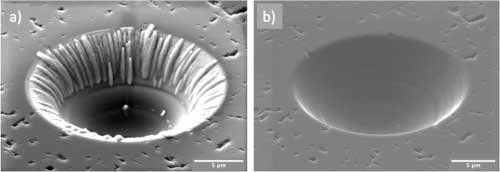| Mar 03, 2020 | |
Scientists created the first diamond x-ray micro lens(Nanowerk News) After the synchrotrons of the fourth generation were invented (these are particle accelerators, which are, in fact, giant research facilities), there was an urgent need for a fundamentally new optics that could withstand high temperatures and radiation loads created by a powerful x-ray stream. |
|
| Scientists use metal and polymer lenses, but they are short-lived and the image they produce is distorted. | |
| The Optics Express scientific journal has published an article of the IKBFU scientists who offered a new innovative method of diamond x-ray microlens production ("Diamond refractive micro-lenses for full-field X-ray imaging and microscopy produced with ion beam lithography"). | |
 |
|
| Single diamond micro-lens before (a) and after (b) cleaning with hot K2Cr2O acid. (Image: Optics Express) | |
| Polina Medvedskaya, the scientist at the "Coherent Optics for Mega science-class plants" research center explains: "A diamond is a unique and expensive material. But it is almost indestructible which makes the lens made of it more economically profitable than metallic or polymeric ones in the long run. The problem is that a diamond is the hardest material on the planet and it is extremely difficult to process. But we have found a way to do it. The IKBFU scientists used an electron-ion microscope (FIB) to process it." | |
| Another scientist from the center Ivan Lyatun explained: "It is concerning for a layman how is it possible to process something by using a microscope? But we have the microscope set on certain configuration that allows it not only to be used as a tool for analysis, but also to shape objects in the necessary form. Using microscopes like the one we make ultra-thin, nano-level cuts. And so we decided to make a microlens" | |
| The result exceeded scientists' expectations. A series of thinner-than-human-hair lenses were produced and it may be used for in the most powerful synchrotrons and x-ray lasers. According to the scientists, the use of lenses made by them will make it possible to obtain more detailed information about any material - to study the structure of nanostructures, to obtain maximum information about protein crystals, which will make it possible to synthesize new drugs. | |
| In a word, new diamond lenses will allow us to penetrate deeper into the secrets of matter, to find out what was previously hidden from the eyes of man. |
| Source: Immanuel Kant Baltic Federal University | |
|
Subscribe to a free copy of one of our daily Nanowerk Newsletter Email Digests with a compilation of all of the day's news. |
